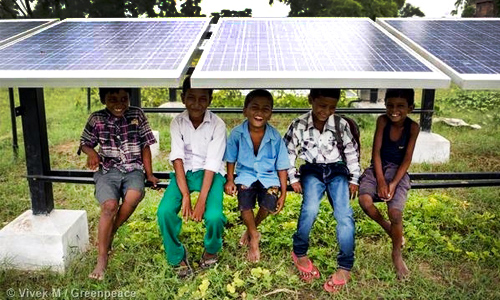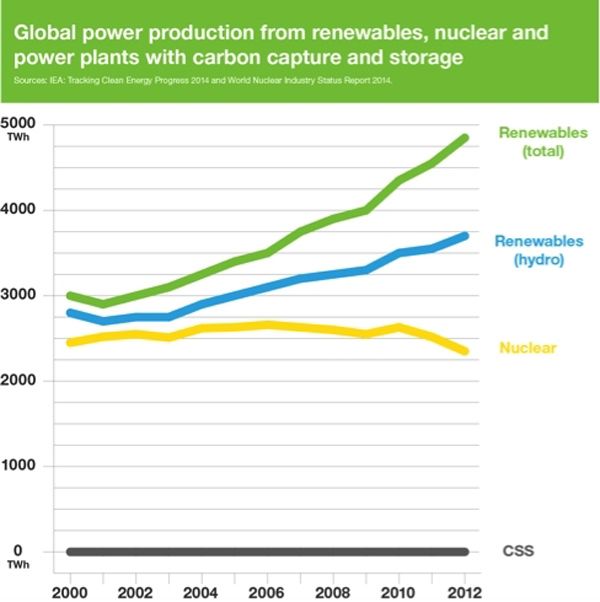

In 2013, commercial solar power reached grid parity (i.e. the point at which it is comparable or cheaper to produce electricity with solar than purchase it from the grid) in Italy, Germany and Spain and will do so soon in Mexico and France.

Source: http://newclimateeconomy.report/energy/
3. Renewables are now mainstream: In the OECD countries, 80 percent of new electricity generation added between now and 2020 is expected to be renewable.

Source: IEA (2014) Medium-Term Renewable Energy Market Report.
In the non-OECD countries, conventional power still dominates, but renewables are already the largest new generation source. Given China’s recent action to curb coal use and restrict new coal plants in some regions, the projection on new conventional generation may still change.

Source: IEA (2014) Medium-Term Renewable Energy Market Report.
4. Individual countries are already reaching high shares of wind, solar and other renewables
- In Spain, wind power was the country’s top source of electricity in 2013, ahead of nuclear, coal and gas. Renewables altogether supplied 42 percent of mainland Spain’s electricity in 2013, and 50 percent in the first half of 2014.
- In Denmark, wind provided for 41 percent of the country’s electricity consumption in the first half of 2014.
- In South Australia, wind farms produced enough electricity to meet a record 43 percent of the state’s power needs during July 2014.
- In the Philippines, renewable energy—mainly geothermal—provides 30 percent of the country’s electricity.
- In the U.S., the states of Iowa and South Dakota produced about 24 percent of their electricity with wind in 2012. Altogether nine US states were producing more than 10 percent of their electricity with wind.
- In India, the state of Tamil Nadu already gets 13 percent of its electricity from wind.
5. Any country can now reach high shares of wind, solar power cost-effectively, says the International Energy Agency.

6. Renewable energy now provides 22 percent of the world’s electricity.

By 2030, wind energy alone could produce a fifth of world’s electricity.
7. Growth rates prove how fast renewables can be deployed and scaled up.
In just two years, Japan has installed 11 GW of solar energy. In terms of electricity, that equals more than two nuclear reactors (building a nuclear plant typically takes a decade or more). Furthermore, Japan has approved 72 GW of renewable energy projects, most of which are solar. This compares to about 16 nuclear reactors, or about 20 coal fired power plant units.
Last year, China installed as much new wind power as the rest of the world combined. This is as many solar panels as the US installed in the past decade. In four years, China aims to double its wind capacity and triple its solar capacity.
In just three years, Germany has increased its share of renewable energy in power from 17 percent to 24 percent. Solar alone produced 30 TWhs of electricity last year, which is equal to the output of about four German nuclear reactors.
Sub-Saharan Africa will add more wind, solar and geothermal energy in 2014 than in the past 14 years in total, while India aims to boost its solar PV capacity more than six-fold in less thank five years, by adding 15 GW by early 2019.
8. Leading investment banks are advising investors to go renewable.
Here’s where the renewables breakthrough is truly visible: annual new investments into clean energy have doubled since 2006/2007, with 16 percent growth recorded so far for this year.
Leading investment banks are advising investors to go renewables.
Citi declared in March this year that the Age of Renewables is Beginning. Renewables are increasingly competitive with natural gas in the US, while nuclear and coal is pretty much out of the game already.
Deutsche Bank considers solar to be competitive without subsidies now in at least 19 markets globally. They also see prices declining further in 2014. HSBC analysts suggest wind energy is now cost competitive with new coal energy in India, and solar will reach parity around 2016-18.
UBS analysts, according to the Guardian, suggest that big power stations in Europe could be redundant within 10-20 years! Technological advances, like electric cars, cheaper batteries and new solar technologies are turning dirty power plants into dinosaurs faster than expected.
9. Renewable energy delivers for communities and builds resilience.
Not having access to electricity means missing out on many opportunities in life. This is still reality for about 1.3 billion people in the world. But now, renewable energy is making energy access more achievable. Its technologies are by now significantly cheaper than diesel or kerosene- based systems, and cheaper than extending the grid in areas with low populations and per capita energy demand.
Local, clean solutions, like microgrids running on solar, give poorer smaller communities control over their own energy destiny. The systems are relatively cheap to maintain and the people living off of their own renewably sourced electricity are not beholden to volatile fossil fuel prices or the unsustainable demands of the massive energy conglomerates.

10. 100% renewable energy is the way to go.
Renewable energy can meet all our energy needs. As the IPCC finds, the technical potential ismuch higher than all global energy demands.
100% renewable energy is what communities, regions, cities—even megacities—and companies are already making a reality through courageous actions and targets.
Sydney, the most populated city in Australia, is going to switch to 100 percent renewable energy in electricity, heating and cooling by 2030. The colder cities are on board too: three Nordic capitals (Oslo, Stockholm and Copenhagen) have all set goals for 100 % renewable energy, whileReykjavik is meeting it already.
Germany’s windy state of Schleswig-Holstein will probably achieve 100% renewable electricity already this year, while Cape Verde, an Island country in Africa, aims to get there by 2020. In Denmark, the whole country aims to meet all its heat and power with 100% renewables in just 20 years and all energy, transport included, by 2050.
There’s plenty, plenty of more, see for example here and here.
Going 100% renewables is a smart business decision too, says leading businesses, including BT, Commerzbank, H&M, Ikea KPN, Mars, Nestle, Philips and Swiss Re. They are campaigning for a goal that by 2020, 100 of the world’s largest companies will have committed to 100% renewable power.
Renewable sustainable energy sources are no longer the stuff of science fiction. Every day there are more and more examples of it being used and improved upon across our fragile planet.
Yet, clean energy hasn’t won just yet. The powerful fossil fuel industry with their allies are fighting back hard, with the help of hundreds of billions of government subsidies they are still enjoyingannually.
This raises the question: where do you want to be? Stuck in the dark ages of fossil fuels, or basking in the sun and wind of a clean energy future?
YOU MIGHT ALSO LIKE
Developing Countries Invest in Renewables Twice the Pace of Industrialized Nations
Renewables Beat Coal, Oil and Nukes by 35 Times in New Energy Capacity

 233k
233k  41k
41k  Subscribe
Subscribe 